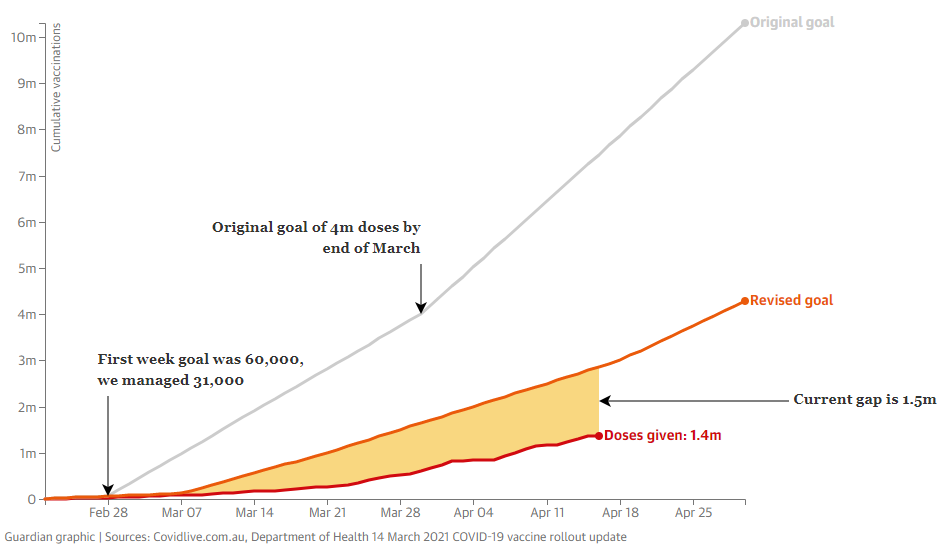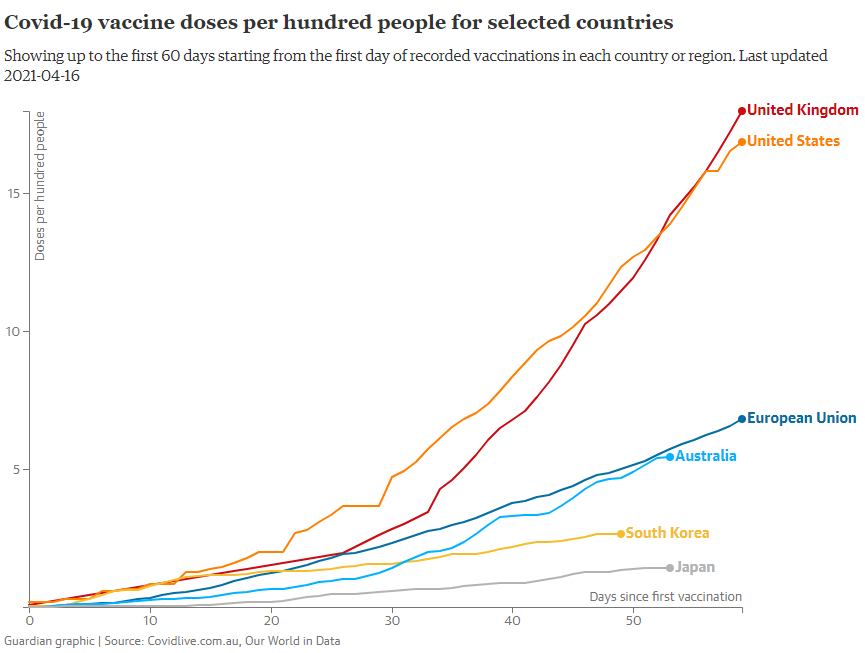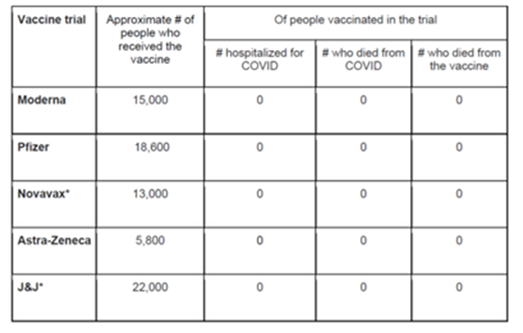We are now into month five of COVID-19 vaccinations globally, and two months into the inoculation process in Australia, a month since our last update.
On 22-Feb: there were 186mln doses administered worldwide across 82 different countries, at a run-rate of 6.34mln doses per day.
On 22-Mar: there were 410mln doses administered worldwide across 132 countries, at a run rate of 9.96mln doses per day.
On 19-Apr: today there are 848mln doses administered worldwide, across 154 countries, at a run rate of 17.9mln doses per day.
Life Returning to Normal
We’re continuing to track vaccinations as a key indicator for when life may return to normal – the old normal – where countries borders will be more open, but also when we reach “herd immunity”, where a critical mass of 70-85% of populations become immune to the current form of COVID-19 through the vaccination process, or through natural build-up of anti-bodies (usually through contracting COVID – obviously not the preferred method).
On a global scale, that’s a daunting level of over 4 billion people being vaccinated, where most vaccines require 2 doses, meaning 8 billion doses need to be administered.
This month’s update is pleasing, as we’re 10% of the way there in 5 months, where production is increasing daily and our run-rate increased accordingly.
Therefore, we can project that the global community should achieve herd immunity in the next 12-15 months.
Australia’s Vaccination Process
In Australia, we’ve managed to increase our run rate, having vaccinated 231k people in one month, and then ~1.1mln people in the 2nd month of vaccinations bringing our total to 1.35mln, or 2.7% of the population receiving a single dose, at a rate of 52k persons, per day.
This is a strong underperformance from the Commonwealth government’s original timetable, where they have since revised our target down substantially.
Remember the original target was 4mln vaccinations by the end of March.
It’s also noticeable that we’re already vastly underperforming our revised goal by some margin as well, where it’s likely the government will shift the goal posts yet again, to address the underachievement.

In terms of how we are faring compared to other nations, the following graphic from The Guardian’s vaccine tracker shows the relevant comparison using figures per 100 persons, a per capita measure of vaccination rates:

All-in-all this suggests that Australian borders will remain closed to most other nations for the foreseeable future – until mid-2022 – where we won’t be able to reopen lest we encounter offshore variants of COVID where we remain susceptible due to low vaccination rates.
Pandemic Pulses
Tracking COVID vaccinations in Australia is a sobering and melancholy task, where our lacklustre performance is a constant reminder that Australian economic performance will be relatively worse than many other nations, due to inability to reopen areas of the economy such as tourism, foreign education services and international travel for Australians.
Personally, COVID19 disrupted my plans to travel with my wife for our honeymoon last year, where that future date remains unknown and given we wanted to go to Africa, likely some years into the future.
However, there is some good news that I think is worth highlighting as well.
We have been incredibly efficient in testing, manufacturing and distributing vaccines, where we have not one but several vaccines within a year after the virus was identified, unprecedented in our history.
Operation Warp Speed was, indeed, a triumph of human work involving cooperation between public and private sectors alongside effort and human ingenuity.
This happened because scientists have been working on the underlying methods and technologies for years already, not knowing they would be useful in a pandemic, but able to utilise them when it became apparent they were applicable.
On this, I’d recommend reading this story by Derek Thompson in The Atlantic.
Briefly, “messenger RNA” or mRNA is a genetic substance that tells your cells which proteins to make. Researchers in various places realised that manipulating mRNA would be useful but weren’t sure how.
This started in 1978 when Hungarian scientist Katalin Kariko discovered mRNA. She took this knowledge and studied at the University of Pennsylvania (USA), where it took over 22 years to see any practicality to her research.
Private companies began using mRNA products, such as Moderna (USA) and BioNTech (Germany), eventually cracking the code and allowing for the mRNA flu vaccine in 2018.
When COVID-19 struck last year, they were quick to modify the flu vaccine into a COVID vaccine, having done similar work already in response to the previous SARS outbreak.
Underappreciation of Vaccine Efficacy
I recently read an article from Professor Justin Stebbing, now journalist at the British Journal of Cancer on the topic of vaccine efficacy.
It became quickly clear that we misinterpreted the statistics of vaccine efficacy.
Consider that the Pfizer and Moderna vaccines are considered 95% effective:
The Pfizer vaccine stage 3 clinical trial engaged nearly 44k people, half of whom received the vaccine, half a placebo.
During this test, 170 people contracted COVID, 162 of the 170 in the placebo group, 8 of the 170 from the vaccine group.
The problem with how this is reported is that the headline number says Pfizer is 95% effective, based on 8 in 170. Otherwise stated, they are comparing the 8 infections as a portion of all the infected cases. This doesn’t accurately depict the true efficacy of the vaccine in stopping contraction of COVID.
The true number should be 8 in ~22,000 (the total number that received the vaccine), or 0.036%, meaning the vaccine is 99.964% effective, not 95%
Likewise, within the Moderna trials that engaged 32k people, they had ONE reported case. One!
Aggregating the vaccine together, there was 74.4k people that trialled vaccines across Moderna, Pfizer, Novavax, AstraZeneca and Johnson & Johnson – across all stages of trials – and not a single person died of COVID within this 74.4k sample, where hospitalisation were also completely reduced as well

This is reason to be positive, as while we may be delayed in getting the vaccine, the world now has the technology to address future viruses.
The views expressed in this article are the views of the stated author as at the date published and are subject to change based on markets and other conditions. Past performance is not a reliable indicator of future performance. Mason Stevens is only providing general advice in providing this information. You should consider this information, along with all your other investments and strategies when assessing the appropriateness of the information to your individual circumstances. Mason Stevens and its associates and their respective directors and other staff each declare that they may hold interests in securities and/or earn fees or other benefits from transactions arising as a result of information contained in this article.



